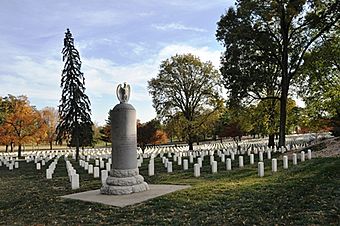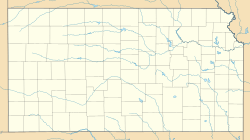Fort Leavenworth National Cemetery facts for kids
Quick facts for kids |
|
|
Fort Leavenworth National Cemetery
|
|

Fort Leavenworth National Cemetery
|
|
| Location | Within Fort Leavenworth military reservation, Fort Leavenworth, Kansas |
|---|---|
| Area | 36.1 acres (14.6 ha) |
| Built | 1862 |
| Architectural style | Second Empire |
| MPS | Civil War Era National Cemeteries MPS |
| NRHP reference No. | 99000834 |
| Added to NRHP | July 15, 1999 |
Fort Leavenworth National Cemetery is a special burial ground for soldiers in the United States. It is located inside Fort Leavenworth, a U.S. Army base in Leavenworth, Kansas. This cemetery was officially started in 1862. However, people were buried here even earlier, in 1844. It was one of the first twelve national cemeteries created by President Abraham Lincoln. Many brave soldiers rest here, including eight who received the Medal of Honor, which is America's highest award for bravery.
The cemetery is named after Brigadier General Henry Leavenworth. His remains were moved here in 1902. Today, the cemetery covers about 36 acres and holds over 22,000 burials. It is managed by the United States Department of Veterans Affairs.
Contents
A Place for Heroes: History of the Cemetery
How the Cemetery Started
In 1862, the United States Congress, which is like the country's main law-making group, passed a law. This law allowed the government to buy land for cemeteries. These cemeteries were meant for soldiers who died while serving their country. By 1870, nearly 300,000 Union soldiers from the American Civil War were buried in 73 national cemeteries.
Most of these cemeteries were near old battlefields or wartime army camps. Fort Leavenworth National Cemetery was one of the largest. It was also connected to a place called the Western Branch National Military Home. This was an "old soldiers' home" (now the VA Eisenhower Medical Center). It became a National Cemetery in 1973.
Growing Over Time
Because of military traditions, the cemetery first had separate areas for officers and regular soldiers. But in 1858, all the remains were moved to one single area. After the Civil War, the bodies of Union soldiers from Kansas City, Kansas and Independence, Missouri, were re-buried at Fort Leavenworth.
The cemetery also became a burial place for soldiers who served at frontier army posts. These posts were in places like New Mexico, Arizona, Colorado, and Wyoming. By 1870, over 1,000 Union soldiers were buried here. There were also about 170 civilians and 7 Confederate prisoners of war.
After the American Indian Wars, between 1885 and 1907, many western army outposts closed. Because of this, about 2,000 more remains were moved and re-buried at Fort Leavenworth. Fort Leavenworth National Cemetery was added to the National Register of Historic Places on July 15, 1999. This means it is recognized as an important historical site.
Brave Soldiers Buried Here
Many notable people are buried at Fort Leavenworth National Cemetery. These include soldiers who showed incredible bravery.
Medal of Honor Recipients
The Medal of Honor is the highest military award for bravery in the United States. Eight recipients are buried here:
- Captain Harry Bell (1860–1938): He received the medal for his actions in the Philippine–American War.
- Captain Thomas W. Custer (1845–1876 †): He was the brother of George Armstrong Custer. Thomas Custer received the Medal of Honor twice during the American Civil War. He was killed in action.
- Navy Lt. Commander William E. Hall (1913–1996): He earned his medal for bravery in World War II.
- Corporal John Kile (1846–1870): He was recognized for his actions in the American Indian Wars.
- Private Fitz Lee (1866–1899): He received the medal for his service in the Spanish–American War.
- Corporal George Miller (1851–1888): He was honored for his actions in the Indian Wars.
- Private Edward Pengally (1824–1874): He received the medal for his bravery in the Indian Wars.
- First Sergeant Joseph Robinson (1850–1874): He was recognized for his actions in the Indian Wars.
- Private Albert D. Sale (1850–1874): He earned his medal for actions in the Indian Wars.
- 1st Sergeant Jacob Widmer (1845–1880): He was honored for his actions in the Indian Wars.
Other Important Army Officers
Several other important army officers are also buried here:
- Brigadier General William Dorrance Beach (1856–1932): A career officer and writer.
- Lt. Colonel David Hillhouse Buel (1839–1870): He was in charge of weapons for the Army of the Tennessee during the Civil War.
- First Lieutenant James Calhoun (1845–1876 †): He was a commander in the 7th Cavalry Regiment. He was also the brother-in-law of Lt. Col. George Armstrong Custer. He was killed in action at the Battle of the Little Bighorn.
- Brigadier General Edward Hatch (1832–1889): He commanded the Buffalo Soldier 9th Cavalry Regiment.
- Brigadier General Henry Leavenworth (1783–1834): The fort and cemetery are named after him.
- Major General William F. Sharp (1885–1947): He commanded a force in the Philippines during World War II. He became a prisoner of war (POW) of the Japanese.
- Captain Algernon Smith (1842–1876 †): An officer in the 7th Cavalry Regiment who died at Little Bighorn.
- Captain George Wilhelmus Mancius Yates (1843–1876 †): An officer in the 7th Cavalry under Lt. Col. George Armstrong Custer. He was killed in action at the Battle of the Little Bighorn.



